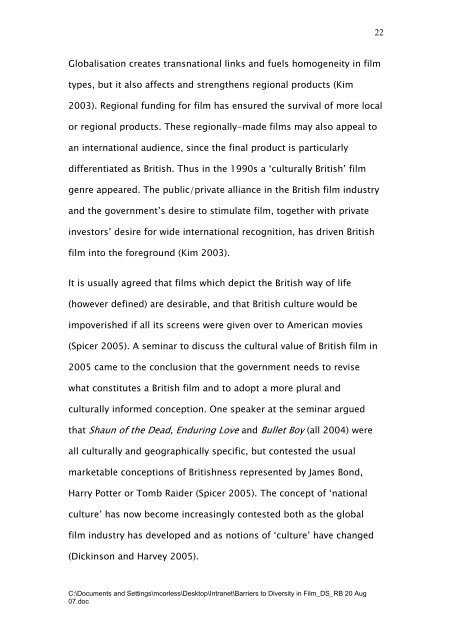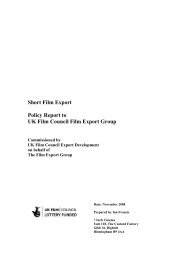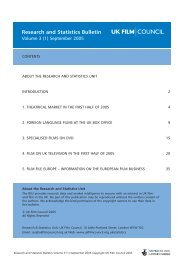Barriers to Diversity in Film – A Research Review – Aug 07
Barriers to Diversity in Film – A Research Review – Aug 07
Barriers to Diversity in Film – A Research Review – Aug 07
Create successful ePaper yourself
Turn your PDF publications into a flip-book with our unique Google optimized e-Paper software.
Globalisation creates transnational l<strong>in</strong>ks and fuels homogeneity <strong>in</strong> film<br />
types, but it also affects and strengthens regional products (Kim<br />
2003). Regional fund<strong>in</strong>g for film has ensured the survival of more local<br />
or regional products. These regionally-made films may also appeal <strong>to</strong><br />
an <strong>in</strong>ternational audience, s<strong>in</strong>ce the f<strong>in</strong>al product is particularly<br />
differentiated as British. Thus <strong>in</strong> the 1990s a ‘culturally British’ film<br />
genre appeared. The public/private alliance <strong>in</strong> the British film <strong>in</strong>dustry<br />
and the government’s desire <strong>to</strong> stimulate film, <strong>to</strong>gether with private<br />
<strong>in</strong>ves<strong>to</strong>rs’ desire for wide <strong>in</strong>ternational recognition, has driven British<br />
film <strong>in</strong><strong>to</strong> the foreground (Kim 2003).<br />
It is usually agreed that films which depict the British way of life<br />
(however def<strong>in</strong>ed) are desirable, and that British culture would be<br />
impoverished if all its screens were given over <strong>to</strong> American movies<br />
(Spicer 2005). A sem<strong>in</strong>ar <strong>to</strong> discuss the cultural value of British film <strong>in</strong><br />
2005 came <strong>to</strong> the conclusion that the government needs <strong>to</strong> revise<br />
what constitutes a British film and <strong>to</strong> adopt a more plural and<br />
culturally <strong>in</strong>formed conception. One speaker at the sem<strong>in</strong>ar argued<br />
that Shaun of the Dead, Endur<strong>in</strong>g Love and Bullet Boy (all 2004) were<br />
all culturally and geographically specific, but contested the usual<br />
marketable conceptions of Britishness represented by James Bond,<br />
Harry Potter or Tomb Raider (Spicer 2005). The concept of ‘national<br />
culture’ has now become <strong>in</strong>creas<strong>in</strong>gly contested both as the global<br />
film <strong>in</strong>dustry has developed and as notions of ‘culture’ have changed<br />
(Dick<strong>in</strong>son and Harvey 2005).<br />
C:\Documents and Sett<strong>in</strong>gs\mcorless\Desk<strong>to</strong>p\Intranet\<strong>Barriers</strong> <strong>to</strong> <strong>Diversity</strong> <strong>in</strong> <strong>Film</strong>_DS_RB 20 <strong>Aug</strong><br />
<strong>07</strong>.doc<br />
22
















